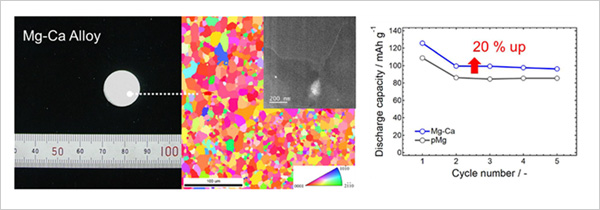Increasing the Deliverable Capacity of Magnesium Metal Batteries through Anode Design
—Techniques Used to Develop Structural Materials Prove Useful in the Development of Low-Cost, Large-Capacity Rechargeable Batteries—
2020.09.30
National Institute for Materials Science (NIMS)
Japan Science and Technology Agency (JST)
NIMS has succeeded in increasing the capacity of magnesium metal batteries by approximately 20% by developing a novel Mg alloy material.
Abstract
- NIMS has succeeded in increasing the capacity of magnesium (Mg) metal batteries by approximately 20% by developing a novel Mg alloy material. Our findings are promising to facilitate the development of efficient Mg metal battery anode materials—an area where research had virtually stagnated—which are vital to increasing battery capacities and lowering production costs.
- To use both renewable energy (e.g., wind, geothermal and solar power) and surplus electricity from power plants effectively, large-capacity rechargeable batteries that are capable of storing electricity from various sources and supplying it on demand are needed to be developed. Lithium ion batteries are commonly used energy storage devices to date nevertheless they would be very hard to use for the above purpose due to their cost for mass production as they contain rare metals, such as cobalt and lithium. Magnesium is a potentially promising alternative because of its relatively large natural abundance, exceeding the amount of lithium in the Earth's crust by more than 1,700 times. In addition, Mg is able to store large amounts of electrical energy. However, the difficulty of processing Mg metal made researching its use in battery anodes unpopular, slowing the effort to develop practical Mg metal batteries.
- A NIMS team consisting of a researcher specialized in the development of Mg battery electrolytes and another researcher with expertise in the development of Mg alloy structural materials recently developed an Mg alloy capable of improving the electrochemical properties of Mg metal batteries. They succeeded in substantially increasing the electrochemical activity of Mg metal materials by fabricating an Mg metal composed of fine grains approximately 20 μm in size with controlled crystallographic orientations. They then doped it with an extremely small amount (0.3% atomic concentration) of a different metal, thereby increasing its electrochemical activity. For example, when calcium was added to Mg metal to form an Mg-Ca alloy which was then used as an anode in an Mg metal battery, the capacity of the battery was found to be approximately 20% higher than that of an Mg metal battery with a pure Mg metal anode. This is the first research in the world that demonstrates that the electrochemical properties of batteries can be improved by alloying Mg metals and controlling their microstructures.
- A metallurgical approach is used extensively in structural materials science. This research demonstrates that this approach is effective in improving the performance of Mg metal batteries. Based on our results, we will continue to optimize the metallographic structures of Mg alloys in an effort to develop large-capacity Mg metal batteries.
- This project was carried out by Toshihiko Mandai (Senior Researcher, Center for Green Research on Energy and Environmental Materials, NIMS) and Hidetoshi Somekawa (Group Leader, Research Center for Structural Materials, NIMS).
This work was supported by the JST ALCA-SPRING program (ALCA: Advanced Low Carbon Technology Research and Development Program, SPRING: Specially Promoted Research for Innovative Next Generation Batteries).
This research was published in the online version of Chemical Communications, a journal of the Royal Society of Chemistry, on September 25, 2020, local time. In addition, this research was selected as a motif for the front cover of the October 13, 2020 issue of this journal (vol. 56, issue 81).

Figure 1. (Left) Newly developed Mg-Ca alloy material. (Middle) Microstructure of the alloy material. (Right) Comparison of the discharge capacities of Mg batteries with pure Mg metal and Mg-Ca alloy anodes.
Related files
- Center for Green Research on Energy and Environmental Materials
- Research Center for Structural Materials(RCSM)
Contact information
(Regarding this research)
-
Toshihiko Mandai
Senior Researcher
Rechargeable Battery Materials Group
Center for Green Research on Energy and Environmental Materials
National Institute for Materials Science
Tel: +81-29-860-4464
E-Mail: MANDAI.Toshihiko=nims.go.jp
(Please change "=" to "@") -
(Contact information when Dr. Mandai is out of office)
Hidetoshi Somekawa
Group Leader
Light-Weight Metallic Materials Group
Design and Producing Field
Research Center for Structural Materials
National Institute for Materials Science
Tel: +81-29-859-2473
E-Mail: SOMEKAWA.Hidetoshi=nims.go.jp
(Please change "=" to "@")
(General information)
-
Public Relations Office
National Institute for Materials Science
Tel: +81-29-859-2026
Fax: +81-29-859-2017
E-Mail: pressrelease=ml.nims.go.jp
(Please change "=" to "@") -
Public Relations Division
Japan Science and Technology Agency
5-3 Yonbancho, Chiyoda-ku, Tokyo 102-8666, Japan
Tel: +81-3-5214-8404
Fax: +81-3-5214-8432
E-Mail: jstkoho=jst.go.jp
(Please change "=" to "@")
(Regarding JST project)
-
Masaru Oya
Department of R&D for Future Creation
Japan Science and Technology Agency
Tel: +81-3-3512-3543
E-Mail: alca=jst.go.jp
(Please change "=" to "@")
Same Keywords
-
Magnesium Sheet Metal with Excellent Room Temperature Formability
(Magnesium,alloy)
2017.06.16
-
Automated High-Throughput System Developed to Generate Structural Materials Databases
(alloy)
2025.07.07
-
Development of a Model Capable of Predicting the Cycle Lives of High-Energy-Density Lithium-Metal Batteries
(battery)
2024.07.24
Recent Press Release
-
Multiple Autonomous AI Systems Spontaneously Collaborate to Advance Materials Research
2025.12.10
-
Simultaneous Imaging of Intracellular DNA and RNA Using Harmless Light
2025.10.27
-
Development of an AI Device Using Ion Gel and Graphene That Dramatically Streamlines Machine Learning Computations
2025.10.14
